Introduction
A particularly bountiful harvest is expected in South Africa in 2003. The wine industry even expects the largest harvest ever. The reasons for this are manifold: the rather wet and cool winter brought an even budding, the cool start of the growing season in combination with sufficient moisture in the soil led to vigorous budding.
January and early February were sometimes very warm. There were some problems here especially in the hotter areas such as the Orange River. Nevertheless, the vines remained healthy and diseases such as powdery mildew either did not occur at all or were kept well under control. As a result, 2003 was almost a year of organic viticulture, as chemical interventions were only marginally necessary. The warm February brought the sugar levels, which had been underdeveloped until then, up well. Thanks to a cool March, the sugar levels did not rise so high and the grapes were able to ripen even longer. Only the Robertson and Rawsonville areas had problems with consistently too cold weather.
The first major rainfall came in March. Those who were able to harvest before then were lucky. The general problems of uneven ripening had to be compensated for by reading in several stages. As in Robertson, there was also flooding in Montagu at this time, which completely destroyed some vineyards. As a result, some farms suffered losses of up to 20%.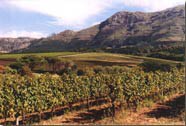 While the yield per tonne of berries was 750 to 800 litres in 2002, it was only 700 to 750 litres in 2003. Nevertheless, the total harvest volume increased by 12.2% compared to the previous year. In some regions, the harvest was even up to 45% higher. The reason for this is the many new vineyards that came into production - especially Shiraz, Cabernet Sauvignon, Cabernet Franc and Pinotage. The increases generally apply to all growing areas (except Orange River), but especially to Stellenbosch, Paarl and Malmesbury.
While the yield per tonne of berries was 750 to 800 litres in 2002, it was only 700 to 750 litres in 2003. Nevertheless, the total harvest volume increased by 12.2% compared to the previous year. In some regions, the harvest was even up to 45% higher. The reason for this is the many new vineyards that came into production - especially Shiraz, Cabernet Sauvignon, Cabernet Franc and Pinotage. The increases generally apply to all growing areas (except Orange River), but especially to Stellenbosch, Paarl and Malmesbury.
2003 was a dream harvest for most winemakers. Jan Boland Coetzee of the Vriesenhof winery speaks of the "best in 25 years", Louis Strydom of the Rust en Vrede winery describes his wines as having good colour and tannins with low sugar content and gives 8 out of 10 possible points for the year. Many winemakers compare the year in quality with the dream red wine year of 1995, so some very good reds can be expected. For white wines, it was more a year for Chardonnay than for Sauvignon Blanc, especially in the warmer areas.
The growing regions
Stellenbosch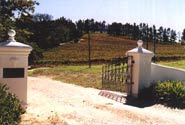 The cool spring and cold soil resulted in uneven budbreak for some varieties. November temperatures were below average, December very hot. January and early February were generally cool and dry, interrupted by short heat waves. In mid-February there were the first signs of drought, so the problems with mildew and rot did not arise, but most varieties ripened almost simultaneously. Due to a cool and rainy March, some rot occasionally occurred in the late-ripening Cabernet Sauvignon and Sauvignon Blanc. The harvest volume increased by 45.72% compared to the previous year, especially for Merlot, Pinotage and Chardonnay. In Stellenbosch, 2003 is a good red wine year, but in area less so for Cabernet Sauvignon and Shiraz.
The cool spring and cold soil resulted in uneven budbreak for some varieties. November temperatures were below average, December very hot. January and early February were generally cool and dry, interrupted by short heat waves. In mid-February there were the first signs of drought, so the problems with mildew and rot did not arise, but most varieties ripened almost simultaneously. Due to a cool and rainy March, some rot occasionally occurred in the late-ripening Cabernet Sauvignon and Sauvignon Blanc. The harvest volume increased by 45.72% compared to the previous year, especially for Merlot, Pinotage and Chardonnay. In Stellenbosch, 2003 is a good red wine year, but in area less so for Cabernet Sauvignon and Shiraz.
For Louis Strydom, 2003 is the best year since he has been at the winery - he awards 8 out of 10 possible points. The berry-fruit ratio is very good and the wine has a good colour and plenty of tannins. For Martin Meinert of Meinert Wines and for Ken Forrester, 2003 is also a good year. The slow development of the sugar levels prevents - fortunately for him - fierce blockbuster wines. He was only worried about some rot in the Sauvignon Blanc and Chenin Blanc. At the Slaley winery, they expect a similar good quality as in 2001, and are particularly pleased with the Sauvignon Blanc, the Pinotage and the Shiraz. Cool temperatures and the absence of diseases lead De Toren to expect a great year, not only in quality but also in yield. The Cabernet Sauvignon is a little uneven in ripeness, but the Merlot and Malbec are excellent.
Constantia
The year was very good for the Constantia wineries. June, July and August were particularly cool and there was more rain than the long-term average. But in the fast-arriving summer, the rain fortunately stayed away, so that hardly any damage was reported. Only a little trouble was experienced with the high altitude vineyards. For Bolea Gerber of Groot Constantia, the Sauvignon Blanc is the best he has ever seen in South Africa in his winemaking life. On Constantia Uitsig, the Sauvignon Blanc shows particularly well and, after fermentation, with aromas of fig and fruit salad rather than grassy notes.
Although yields were generally somewhat lower than last year, we can expect first-class results from Constantia, especially in the white wines. We also heard from Klein Constantia that the Sauvignon Blancs and Chardonnays of this vintage will be much better than in the last two years. At Steenberg, 2003 was the first year that the grapes were harvested with a machine. How this will affect the quality of the wine remains to be seen.
On Groot Constantia the harvest started 10 days later than last year. The grapes were ripe, but had only a low sugar content. Besides Sauvignon Blanc, Chardonnay and Pinotage look the most promising. The maiden vintage of Malbec was also harvested. In addition, 6 ha of Shiraz and 1.5 ha of Touriga Nacionale were planted. Thus, the farm now has 90 ha under vines, of which 60% are red and 40% white varieties.
Paarl
The Paarl wine region is expecting the largest harvest since 1997 with a 45.3% increase over the previous year. Vines sprouted late and because temperatures in October and November were lower than average, there was a long flowering period followed by slightly uneven ripening. Temperatures in January and February were appropriate for the season, but generally dry. So there were no problems with diseases here either. The rain at the end of March brought relief in this very dry period and the harvest started well. 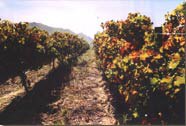 At the top vineyard Veenwouden, the year is being compared to 1998, probably the best Veenwouden year so far. The white varieties in Paarl will be better than 2002: the Chenin Blanc especially, if the grapes could be harvested before the heat wave in February. The hottest day was probably 10 February 2003 with a temperature of 43°C! Because of this heat, the tannins will probably be softer this year, the Pinotage might have a hard time. Good results in general were achieved by Merlot, Shiraz and Cabernet Sauvignon, which often ripened earlier here than in neighbouring Stellenbosch.
At the top vineyard Veenwouden, the year is being compared to 1998, probably the best Veenwouden year so far. The white varieties in Paarl will be better than 2002: the Chenin Blanc especially, if the grapes could be harvested before the heat wave in February. The hottest day was probably 10 February 2003 with a temperature of 43°C! Because of this heat, the tannins will probably be softer this year, the Pinotage might have a hard time. Good results in general were achieved by Merlot, Shiraz and Cabernet Sauvignon, which often ripened earlier here than in neighbouring Stellenbosch.
In the Wellington sub-region, local producers put 2003 on a par with 2001, their best production year to date. Bertrus Fourie from Diemersfontein speaks of a "great, but difficult year", because all varieties ripened here almost at the same time. On the other hand, the qualities look particularly good. Due to the excellent weather conditions, there were no diseases at the Plaisir de Merle vineyard (Franschhoek), but there were some problems with uneven ripening in the red varieties. The blocks therefore had to be harvested two or three times. The berries ripened later but slower, which is why tannins and concentration will be better, but the alcohol content in the wines will be lower.
Durbanville
In Durbanville, even better qualities are expected than in the very good 2001 vintage. Some of the red varieties hung until mid-April. Sauvignon Blanc, one of the flagships of the Atlantic region, will probably be first class. 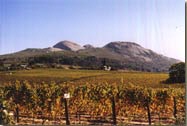 The harvest on Durbanville Hills started on 24 January and continues into March in the order of Sauvignon Blanc, Chardonnay, Pinotage, Merlot, Cabernet Sauvignon and Shiraz. 2003 was the first harvest here, utilising the full cellar capacity of 8000. For the first time, a mobile laboratory was also used to test the qualities of the producers on site and no longer in Stellenbosch. Most of the wines look very promising.
The harvest on Durbanville Hills started on 24 January and continues into March in the order of Sauvignon Blanc, Chardonnay, Pinotage, Merlot, Cabernet Sauvignon and Shiraz. 2003 was the first harvest here, utilising the full cellar capacity of 8000. For the first time, a mobile laboratory was also used to test the qualities of the producers on site and no longer in Stellenbosch. Most of the wines look very promising.
Elgin
Due to the very cool weather conditions, the harvest in Elgin was only started when they had already finished in Stellenbosch. Of the white varieties, the Sauvignon Blanc is much better than last year, among the red varieties, the Pinotage looks particularly promising.
Walker Bay (Hemel en Aarde)
In Walker Bay, the rain from mid to late February led to rot in places. The harvest was not as nervous as in 2002, but still mixed. There are good pH and sugar levels, but some areas are very ripe and others have been difficult to reach maturity. Bouchard Finlayson will get Sauvignon Blanc at 13.5% alcohol for example, on the other hand there were problems getting "colour" into the Pinot Noir.
Robertson
#Also here we had a cool winter with relatively low rainfall and strong winds in September and November. The heatwaves in February were punctuated by heavy rain, with some flooding on 23 and 24 March, particularly in the Ashton, Goudmyn and McGregor regions. After these rains, problems with mildew and slugs occurred. Nevertheless, one of the healthiest harvests was also harvested here. Particularly good qualities are to be expected from the white varieties, which could be harvested before the heat waves in February. The red varieties are generally good, Pinotage and Shiraz particularly good.
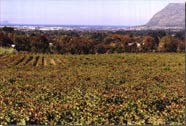 Johan Lotz from Deetlefs Estate (Rawsonville) expects the best harvest since 1999 and hopes for numerous awards for his 2003s. He expects most from Sauvignon Blanc, Chardonnay and Pinotage. Kobus Rossouw from the Jason's Hill vineyard in the Slanghoek Valley considers the 2003 harvest to be the best in the region for 25 years. Yields were down, but the quality is excellent. At Zandvleit Estate, a 20 to 30% decline in Chardonnay was noted due to low bud break and flowering, but the quality was promising. Problems were only encountered with Merlot, as it was difficult to achieve the desired sugar levels. Abrie Bruwer from Springfield Estate reported good weather and a good harvest, with the Chardonnay and Sauvignon Blanc receiving the best ratings.
Johan Lotz from Deetlefs Estate (Rawsonville) expects the best harvest since 1999 and hopes for numerous awards for his 2003s. He expects most from Sauvignon Blanc, Chardonnay and Pinotage. Kobus Rossouw from the Jason's Hill vineyard in the Slanghoek Valley considers the 2003 harvest to be the best in the region for 25 years. Yields were down, but the quality is excellent. At Zandvleit Estate, a 20 to 30% decline in Chardonnay was noted due to low bud break and flowering, but the quality was promising. Problems were only encountered with Merlot, as it was difficult to achieve the desired sugar levels. Abrie Bruwer from Springfield Estate reported good weather and a good harvest, with the Chardonnay and Sauvignon Blanc receiving the best ratings.
Swartland and Tulbagh
This wine-growing region experienced one of its healthiest years. The winter before was cool with plenty of rainfall, meaning the season started well. Temperatures in October and November were lower than average, and temperatures from December to the end of the harvest were normal. As there was hardly any summer rain, rot did not occur, but the water supplies in the dams had to be used with caution so as not to use them up too quickly. Overall, the growth of the vines was even, everything ripened at low sugar levels. As a result, the alcohol content of the wines will also be lower.
The harvest volume has increased by 31.8% compared to the previous year, making it the largest harvest in 15 years. This is also due to the fact that various new vineyards with Petit Verdot, Malbec and Viognier came into production. Winemaker Danie Malan of the Allesverloren winery reports larger harvests than last year and praises the good weather conditions, which have ensured better quality.
Orange River
In the Orange River growing region, the harvest was 18.5% smaller than last year because it was too dry overall. From the beginning of flowering until the beginning of February, it was consistently very hot. Rain fell sporadically from mid to late February. Especially for hemp poot, the yield was much lower: late powdery mildew and frost in early May resulted in a poor start to the season. Overall, however, the region had few problems with diseases and the berries generally showed good quality. Good results can be expected from Colombard and Chenin Blanc.
The grape varieties
Sauvignon Blanc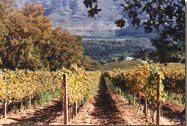 As already mentioned, the 2003 harvest will be good and especially the Sauvignon Blanc looks first class in most areas. The wines produced from it will be more tropical than grassy in aroma due to the warm temperatures, with the cooler regions more likely to deliver ripe flavours, greener flavours are more likely from the warmer regions. At the Bellingham estate in Wellington (Paarl), they brought in the best grape material of the variety, as it could be harvested before the heat waves in February. The Sauvignon Blanc grapes at Bloemdal ripened very late due to the cold November, at Robertson December was very hot and the grapes are riper but healthier than 2002 with more flavours and similar acidity to 2001. At Neil Ellis and at Warwick Estate the Sauvignon Blanc looks good and will be similar to the 2001. Also at the Steenberg Estate, winemaker John Loubser compares the 2003 Sauvignon Blanc with the - for the grape variety - top harvest of 2001. Most other winemakers who grow Sauvignon Blanc put the 2003 vintage on a par with 2001 or even slightly above.
As already mentioned, the 2003 harvest will be good and especially the Sauvignon Blanc looks first class in most areas. The wines produced from it will be more tropical than grassy in aroma due to the warm temperatures, with the cooler regions more likely to deliver ripe flavours, greener flavours are more likely from the warmer regions. At the Bellingham estate in Wellington (Paarl), they brought in the best grape material of the variety, as it could be harvested before the heat waves in February. The Sauvignon Blanc grapes at Bloemdal ripened very late due to the cold November, at Robertson December was very hot and the grapes are riper but healthier than 2002 with more flavours and similar acidity to 2001. At Neil Ellis and at Warwick Estate the Sauvignon Blanc looks good and will be similar to the 2001. Also at the Steenberg Estate, winemaker John Loubser compares the 2003 Sauvignon Blanc with the - for the grape variety - top harvest of 2001. Most other winemakers who grow Sauvignon Blanc put the 2003 vintage on a par with 2001 or even slightly above.
Pinotage
2003 can be the best Pinotage year of the last 20 years - this is the opinion of numerous producers and a group of wine experts who have already tasted numerous barrel samples. 2003 is compared to the parade years 1984 and 1998, but the techniques in viticulture have improved further and the vineyards are older. So it remains exciting to see what the 2003 Pinotage will look like with the top producers and what ageing potential it will have.
© Helge Hagener, www.SA-Weine.de